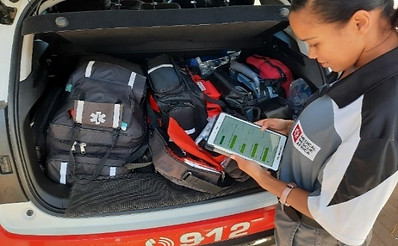
REMOTE SITE TELEMEDICINE
Medical Rescue Africa’s (MRA) Remote Site Telemedicine service brings professional medical expertise directly to your location – no matter how far from the nearest hospital. Designed for mining sites, offshore platforms, lodges, exploration camps, and other isolated environments, our telemedicine solutions provide immediate, reliable access to doctors and specialists 24 hours a day.
Real-Time Medical Consultations
Through secure video or audio links, our telemedicine service connects on-site personnel or patients directly with MRA’s on-call doctors. On-site medics or nurses can carry out examinations and relay vital signs, enabling accurate diagnosis and treatment guidance without the need for an in-person doctor.


Continuous Monitoring & Support
Our telemedicine system supports ongoing patient monitoring, ensuring continuity of care from initial assessment to recovery. This means that even when a patient is off-site or between shifts, medical professionals can track progress, adjust treatment plans, and respond immediately to any changes in condition.
Reduced Evacuations, Lower Costs
By enabling early diagnosis and treatment on-site, telemedicine significantly reduces the need for unnecessary medical evacuations – saving time, lowering operational costs, and minimising disruptions to your operations. Evacuations are only initiated when absolutely necessary, and when they are, MRA coordinates every step through our 24-Hour Emergency Operations Centre.


Secure Medical Record Sharing
All consultations and medical records are securely stored and accessible only to authorised healthcare providers. This allows detailed patient histories to be shared instantly with the patient’s family doctor or specialist, improving the accuracy and quality of ongoing care.
Key Benefits of MRA Remote Site Telemedicine
-
Rapid access to qualified medical professionals at any time
-
Enhanced safety for personnel in remote and high-risk locations
-
Reduced downtime and improved operational efficiency
-
Integrated with MRA’s medical evacuation and emergency response services
-
Tailored solutions for different industries and operational environments


Tailored for Your Industry
Whether supporting a mining operation deep in Namibia’s interior, an offshore vessel in African waters, or a luxury safari lodge in the wilderness, MRA designs telemedicine solutions that align with your operational requirements and risk profile. Our flexible packages ensure you only pay for the level of coverage you need – without compromising on quality of care.
With MRA Remote Site Telemedicine, expert medical support is never more than a call away – ensuring the safety, well-being, and productivity of your team wherever they are.